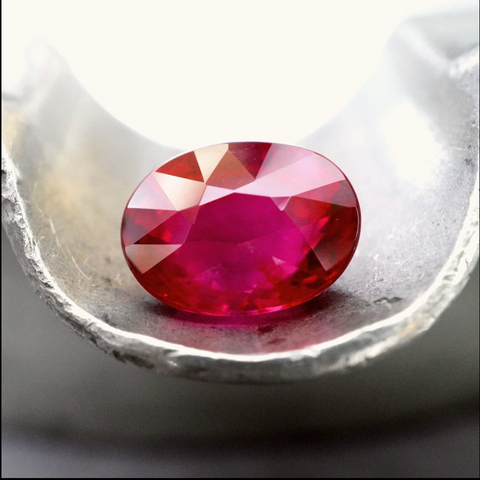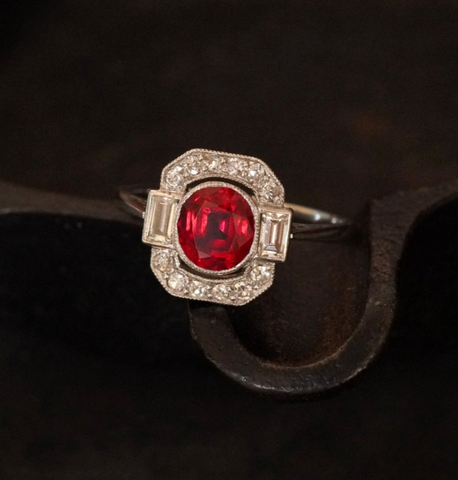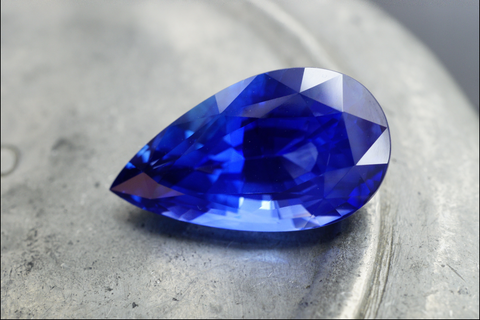
Why Invest in Untreated Ruby Gemstones and Natural Sapphires?
In the realm of precious gemstones, rubies and sapphires are timeless classics, cherished for their breathtaking hues and enduring beauty. However, not all rubies and sapphires are created equal, and savvy investors understand the importance of discerning between treated and untreated sapphire stones.
Untreated rubies and sapphires hold a unique allure and investment potential that sets them apart from their treated counterparts. In this article, we delve into a few common treatments for these stones and why investing in untreated rubies and sapphires is a prudent choice for gemstone buyers.
15.31-carat, pear-shaped, unheated blue sapphire from Sri Lanka
Understanding Gemstone Treatments
Gemstone treatments encompass a range of processes aimed at enhancing a stone’s color and/or clarity and overall appearance. While some treatments are widely accepted within the industry, others can significantly impact a gemstone’s value and desirability. A few common treatments that are utilized for rubies and pink sapphires include:
Heat Treatment: Heat treatment is a widely practiced treatment method that involves subjecting gemstones to controlled heating to improve their color and clarity. In rubies, heating can transform purplish coloration into a more vibrant red hue, resulting in a color that’s perceived as purer and more desirable. In sapphires, heating can intensify, or even induce, a blue coloration.

3.30-carat, cushion-shaped, unheated Burmese ruby
Additionally, heat treatment can also remove “silk”—minute needle–like inclusions within both types of gemstones—that can cause them to appear lighter in tone and less transparent. In contrast, heat treatment can also cause recrystallization of the silk inclusions to make them more prominent, which allows a burmese ruby or sapphire to have a stronger asterism, or distinct star-like pattern, within the gemstone when viewed under certain lighting conditions. This asterism creates a mesmerizing reflecting-star effect that further enhances the gemstones’ allure and rarity.
Heat treatments applied to rubies and sapphires are generally regarded as durable and long-lasting under normal handling conditions. However, heat-treated rubies and natural blue sapphire do not confer the same value as untreated specimens when considering them as investments. While such treatments are generally considered resilient in everyday use, their value does not match that of untreated rubies and sapphires.
Beryllium Diffusion: Diffusion is the penetration of certain elements into the atomic lattice of a gemstone during heat treatment to accentuate or change its color.

3.75-carat, step-cut, unheated, pink-purple sapphire from Sri Lanka
During the 1980s, research into treatments for rubies and sapphires centered on the diffusion of titanium and chromium, both of which act as coloring agents in corundum, the mineral from which these gemstones derive. However, efforts to achieve complete color penetration within the mineral were largely unsuccessful. In contrast to titanium and chromium, beryllium, which has a much smaller atom size, demonstrated the ability to penetrate even large rubies and sapphires completely, resulting in a notable alteration of their color.
While beryllium diffusion can produce vibrant hues in gemstones, it’s generally frowned upon in the industry due to its significant alteration of a gem’s natural composition.
Fracture- or Cavity-Filling: These filling treatments are commonly used to hide surface-reaching fractures or cavities present within a gemstone. Typically for rubies and sapphires, the filling material is lead glass due to its ability to closely match the refractive index of these stones. However, other materials such as oil, resin and other polymers can also be utilized to enhance the apparent clarity and overall appearance of gems. Moreover, these treatments are intended to enhance a gem’s stability, or, in rare instances, slightly increase its weight.
While fracture- or cavity-filled rubies and sapphires might exhibit improved color and clarity initially, these treatments significantly compromise the integrity and value of the stones, rendering them virtually worthless in the eyes of discerning buyers.

5.29-carat, unheated, sugarloaf cabochon Burmese ruby
Understanding these treatments is essential for gemstone buyers to make informed decisions when investing in rubies and sapphires. While heat treatment is generally more accepted than treatments such as beryllium diffusion and fracture- or cavity-filling, they all can compromise the soundness and worth of these stones. Therefore, investing in untreated rubies and sapphires ensures authenticity, purity and long-term value preservation for discerning collectors and investors.
Value Proposition of Untreated Gemstones
Investing in untreated rubies and sapphires offers numerous advantages over their treated counterparts. Untreated gemstones possess a natural beauty and intrinsic merit that resonate with collectors and investors seeking rare and exceptional specimens and therefore command premium prices in the market.
Typically, untreated rubies and sapphires trade at significantly higher prices compared to treated stones, often fetching ten times or more the value of their treated counterparts. This premium reflects the rarity and desirability of unaltered gemstones prized for their inherent allure.

Jogani original ring featuring an 18.69-carat, cushion-shaped, unheated Burmese blue sapphire
Unlike treated gemstones, which undergo artificial enhancements that can compromise their structural integrity, untreated rubies and sapphires retain their original characteristics and beauty. This preservation of integrity ensures that the gemstones maintain their value over time, making them enduring investments for collectors and investors.
Importance of Certification and Disclosure
In the pursuit of untreated gemstones, thorough certification and disclosure are paramount to guaranteeing the quality and authenticity of the investment. Gemological certificates serve as vital documentation, offering comprehensive insights into a stone’s origin, characteristics and any treatments it has undergone.

Jogani original ring featuring a 12.42-carat, cushion-shaped, unheated padparadscha sapphire
When considering investments in untreated rubies and sapphires, it’s imperative to obtain multiple certificates from reputable gemological laboratories. Trusted names such as the Gemological Institute of America (GIA), the American Gemological Laboratories (AGL) and the Swiss Gemmological Institute (SSEF) are renowned for their rigorous testing protocols and unbiased evaluations. By seeking certifications from these esteemed institutions, investors can ensure transparency, authenticity and confidence in a gemstone’s quality.
It’s also important to periodically update your gemstone certificates to reflect the most accurate information available. Over time, advancements in gemological testing and detection methods may reveal treatments that were previously undisclosed or undetectable. This proactive approach safeguards against potential discrepancies and ensures the integrity of your investment.

Art Deco-style ring featuring a 1.86-carat, oval-shaped, unheated, pigeon's blood–red Burmese ruby stones and diamonds
Gemstone sellers and dealers should also adhere to ethical standards of disclosure, providing full transparency regarding any treatments or enhancements applied to a stone. For buyers, conducting due diligence and seeking multiple opinions from qualified gemologists can help verify the authenticity and value of untreated rubies and sapphires.
Investing in untreated rubies and sapphires represents a judicious choice for gemstone buyers seeking exceptional authenticity, rarity and value. By prioritizing unaltered gemstones and conducting thorough due diligence, investors can build a collection of unique and coveted specimens with enduring investment potential. With proper certification, disclosure and appreciation for the inherent allure of these untreated stones, investors can embark on a rewarding journey in the world of precious gems.
Top: 2.76-carat, octagonal-shaped, unheated Burmese ruby
All gems and jewels from the Jogani collection



